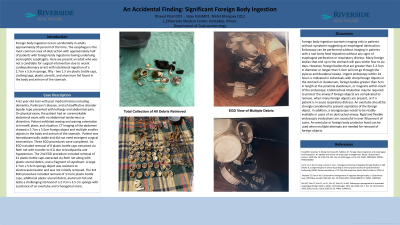Sunday Poster Session
Category: Interventional Endoscopy
P0893 - An Accidental Finding: Significant Foreign Body Ingestion
Sunday, October 22, 2023
3:30 PM - 7:00 PM PT
Location: Exhibit Hall

Has Audio
- VK
Vijay Kata, MD, MS
Riverside Medical Center
Kankakee, IL
Presenting Author(s)
Vijay Kata, MD, MS, Dhaval Patel, DO, Nikhil Bhargava, DO
Riverside Medical Center, Kankakee, IL
Introduction: Foreign body ingestion occurs accidentally in adults approximately 95 percent of the time. The esophagus is the most common area of obstruction with approximately half of patients with foreign body ingestions having underlying eosinophilic esophagitis. Here we present an adult who was not a candidate for surgical intervention due to recent cardiopulmonary arrest with non-accidental ingestion of a 2.7cm x 5.5cm sponge, 52 ensure bottle caps, clothing tags, plastic utensils, and aluminum foil found in the body and antrum.
Case Description/Methods: A 62 year-old man with past medical history including dementia, Parkinson's disease, and schizoaffective disorder-bipolar type who presented with lethargy and abdominal pain. On physical exam, the patient had no abdominal tenderness and no abdominal distention. Patient had a waxing and waning orientation of himself, place, and situation. CT imaging of the abdomen showed a 2.7cm x 5.5cm foreign object and multiple smaller objects in the body and antrum of the stomach. Imaging showed no evidence of bowel obstruction, pneumatosis or free intraperitoneal air. Patient was hemodynamically stable and did not need emergent surgical intervention. Three EGD procedures were completed with removal of 52 Ensure bottle caps, plastic utensil debris, styrofoam fragments, aluminum foil debris, and a 2.7cm x 5.5cm sponge.
Discussion: Foreign body ingestion warrants imaging only in patients without symptoms suggesting an esophageal obstruction. Endoscopy can be performed without imaging in patients with a non bony food impaction without any signs of esophageal perforation or respiratory distress. Many foreign bodies that end up in the stomach will pass within four to six days. However, foreign bodies that are greater than 2-2.5cm in diameter or longer than 5-6cm will not go through the pylorus and duodenal sweep, respectively. Urgent endoscopy within 24 hours is indicated in individuals with sharp foreign objects in the stomach or duodenum, foreign bodies greater than 5cm in length at the proximal duodenum, or magnets within reach of endoscope. Endotracheal intubation may be required to protect the airway if foreign objects are complicated to remove, when many foreign objects are present, or if a patient is in acute respiratory distress. An overtube should be strongly considered to prevent aspiration of the foreign object. An overtube or foreign body protector hood can be used when multiple attempts are needed for removal of foreign objects.

Disclosures:
Vijay Kata, MD, MS, Dhaval Patel, DO, Nikhil Bhargava, DO. P0893 - An Accidental Finding: Significant Foreign Body Ingestion, ACG 2023 Annual Scientific Meeting Abstracts. Vancouver, BC, Canada: American College of Gastroenterology.
Riverside Medical Center, Kankakee, IL
Introduction: Foreign body ingestion occurs accidentally in adults approximately 95 percent of the time. The esophagus is the most common area of obstruction with approximately half of patients with foreign body ingestions having underlying eosinophilic esophagitis. Here we present an adult who was not a candidate for surgical intervention due to recent cardiopulmonary arrest with non-accidental ingestion of a 2.7cm x 5.5cm sponge, 52 ensure bottle caps, clothing tags, plastic utensils, and aluminum foil found in the body and antrum.
Case Description/Methods: A 62 year-old man with past medical history including dementia, Parkinson's disease, and schizoaffective disorder-bipolar type who presented with lethargy and abdominal pain. On physical exam, the patient had no abdominal tenderness and no abdominal distention. Patient had a waxing and waning orientation of himself, place, and situation. CT imaging of the abdomen showed a 2.7cm x 5.5cm foreign object and multiple smaller objects in the body and antrum of the stomach. Imaging showed no evidence of bowel obstruction, pneumatosis or free intraperitoneal air. Patient was hemodynamically stable and did not need emergent surgical intervention. Three EGD procedures were completed with removal of 52 Ensure bottle caps, plastic utensil debris, styrofoam fragments, aluminum foil debris, and a 2.7cm x 5.5cm sponge.
Discussion: Foreign body ingestion warrants imaging only in patients without symptoms suggesting an esophageal obstruction. Endoscopy can be performed without imaging in patients with a non bony food impaction without any signs of esophageal perforation or respiratory distress. Many foreign bodies that end up in the stomach will pass within four to six days. However, foreign bodies that are greater than 2-2.5cm in diameter or longer than 5-6cm will not go through the pylorus and duodenal sweep, respectively. Urgent endoscopy within 24 hours is indicated in individuals with sharp foreign objects in the stomach or duodenum, foreign bodies greater than 5cm in length at the proximal duodenum, or magnets within reach of endoscope. Endotracheal intubation may be required to protect the airway if foreign objects are complicated to remove, when many foreign objects are present, or if a patient is in acute respiratory distress. An overtube should be strongly considered to prevent aspiration of the foreign object. An overtube or foreign body protector hood can be used when multiple attempts are needed for removal of foreign objects.

Figure: A.EGD Straight View of Debris
B. Total Collection of All Debris Removed from Multiple EGD Procedures
B. Total Collection of All Debris Removed from Multiple EGD Procedures
Disclosures:
Vijay Kata indicated no relevant financial relationships.
Dhaval Patel indicated no relevant financial relationships.
Nikhil Bhargava indicated no relevant financial relationships.
Vijay Kata, MD, MS, Dhaval Patel, DO, Nikhil Bhargava, DO. P0893 - An Accidental Finding: Significant Foreign Body Ingestion, ACG 2023 Annual Scientific Meeting Abstracts. Vancouver, BC, Canada: American College of Gastroenterology.
